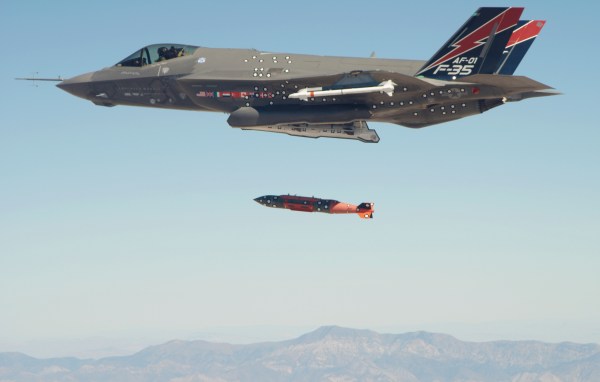"You guys sure this thing works?" Air Force weapons handlers tend to a BLU-109.
There’s nothing worse than dropping bunker-busters on enemy bunkers that don’t bust.
That’s the Air Force’s challenge following the recent discovery that an estimated 2.5% of its BLU-109 bunker-busting bombs have “anomalies”—cracks, apparently—in its thick steel nose. That might thwart their ability to punch through up to six feet of concrete into Dr. Evil’s most diabolical lairs and weapons-storage sites, and blow them to smithereens.
“It is unknown if these anomalies negatively affect lethality, performance, or alter the Operational Suitability and Effectiveness of the weapon system,” the Air Force said Thursday in its hunt for experts who can determine if the bombs possessing such flaws are nonetheless ready for prime time, or need to be fixed in some way. The company that makes the BLU-109’s casing discovered the problem and alerted the Bombs Division of the Air Force Life Cycle Management Center at Hill Air Force Base, Utah.
The fact that the Air Force is concerned over a possible 2.5% failure rate shows how bombing has changed. In World War II, a U.S. bomber had a 1.2% chance of hitting a 100-foot square target. A sky-darkening fleet of 220 warplanes was needed to destroy a target…90% of the time. (And it wasn’t only bombers: the Army fired 10,000 rounds of small-arms ammo to wound an enemy soldier, and 50,000 to kill one. It wasn’t only the Americans, either: Germany filled the European skies with 16,000 flak shells to bring down a single allied heavy bomber.)
As wars have changed—broadcast around the globe in real time, around the clock—every bomb counts. Strikes tend to be surgical, and bunker-busting missions even more so. If there’s one thing worse that missing your target, it’s hitting your target to no effect. No Air Force officer wants to have to explain why a bomb delivered precisely on a target—an Iranian nuclear site, for the sake of conversation—basically bounced off.
That’s why the Air Force is looking to give a company “a government supplied anomalous-bomb casing and inert filler.” Think of it as a jelly doughnut, with the jelly replaced with a crème filling. Next March, it is slated to be loaded onto a sled and sped along a track, smashing into into a simulated bunker at New Mexico’s Holloman Air Force Base.
The test bomb “will be fitted with an array of internal instrumentation and sensors that can withstand an impact at a sled test track and maintain integrity of all acquired data,” the service says. “Strain gages should be installed on the inner surface of the nose region next to the crack location,” it adds. “Sampling rate shall be sufficient [the service recommends 16,000 measurements per second] to accurately record the maximum strain response near the cracked region during the entire penetration event…”
Following the test, “the data will then be analyzed and used to build a qualitative conclusion of whether or not an anomalous nose section affects the performance criteria upon impact,” the Air Force says.
BLU-109s have been in the Pentagon’s inventory since 1985. They are filled with 550 pounds of high explosive Tritonal. Think of it as high-octane TNT. It’s actually a combination of 80% TNT and 20% aluminum powder that is 18% more powerful than TNT alone. The BLU-109’s tail fuze delays the bomb’s detonation until the bomb has penetrated the targeted bunker, “ensuring complete destruction of the location,” the Air Force says.
Assuming a proper nose job, of course.


